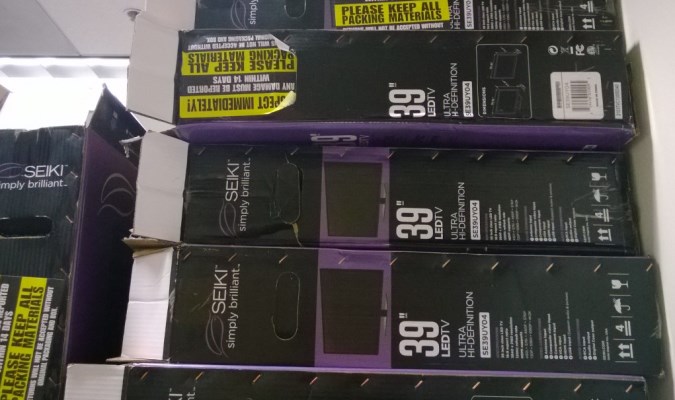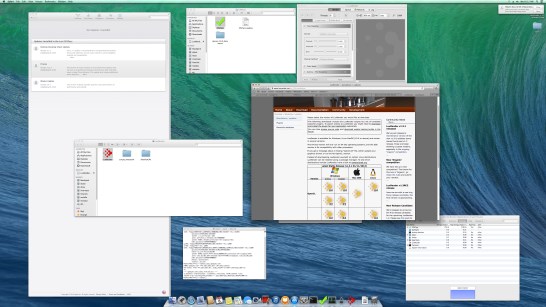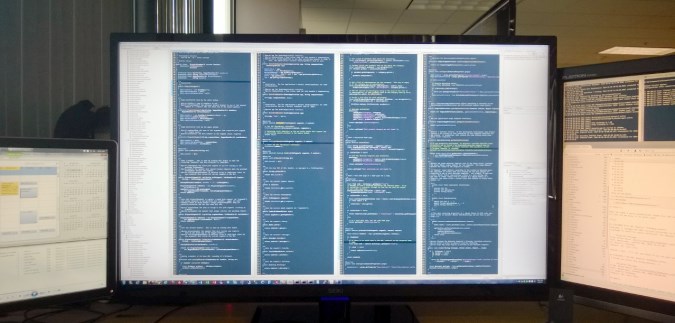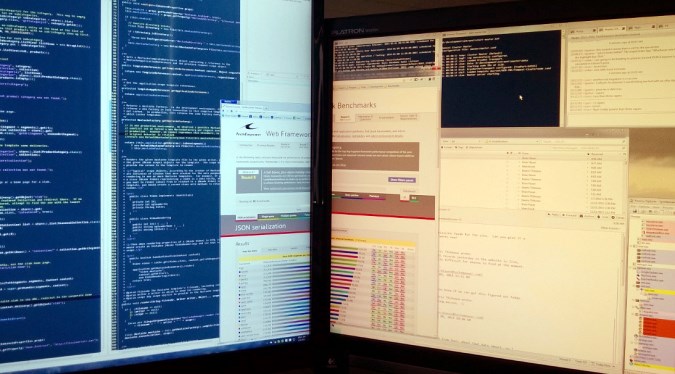 Also read the follow-up for more thoughts on computing with a 4k television.
Also read the follow-up for more thoughts on computing with a 4k television.At our office, we just equipped all of the programmers' workstations with Seiki 39" 4K televisions as monitors. At $500 a piece, you should be doing the same. For the time being, there is no single higher-productivity display for a programmer.
Heralded by some as a "
breakthrough," the Seiki monitor—ahem, television—does have its limitations. Most notably, the HDMI 1.4 ports can only support 30Hz at the signature 3840x2160 resolution.
Lower-end GPUs are also similarly limited to 30Hz at that resolution. The GPU in a truly old desktop PC will not support 3840x2160 at all, but if you are programming on something so old, you should first contend with that.
I equipped my wife's home computer
with one of these Seiki televisions before the price dropped from $700 to $500. Even having paid that $200 early adopter premium, that price was significantly lower than other 4K displays. (Is it any surprise that
Dell and others are finally reacting to this new pricing reality?)
The fact that Seiki markets their 4K display as just a television betrays a bit of marketing ignorance. Seiki is missing a golden opportunity to dominate the desktop display market by removing the television tuner, speakers, and remote, and then reallocating that budget to a 60Hz or better input (HDMI 2 and/or DisplayPort), a matte screen surface, and instant-on DPMS support, all the while retaining the market-wrecking price. After establishing that foothold, Seiki should deliver a smaller 4K (32" or so) at the same price or lower, and push for 8K or higher at large form-factor (around 50").
At the office, we had been using antiquated pairs of 19-inch monitors. An upgrade was needed. What to choose? Today, you can still buy a 30-inch 2560x1600 display for over $1,000. Or you can get a 39-inch 3840x2160 display for $500. This choice is not even fair.

One initially-skeptical colleague fired up his code editor, took a moment to savor the spectacle, and then the epiphany: "I didn't really
get it until just now." Four editors side-by-side each with over a hundred lines of code, and enough room to spare for a project navigator, console, and debugger. Enough room to visualize the back-end service code, the HTML template, the style-sheet, the client-side script, and the finished result in a web browser—all at once without one press of
Alt-tab.
Some people don't intrinsically appreciate the appeal of large displays for desktop computing, but many of those folks will become converts when they use one. Remember when people argued that the iPad 2 resolution of 1024x768 was good enough? I have
had enough of good enough.
I want a 50-inch desktop display with north of 10,000 horizontal pixels. Had desktop computing avoided the
taint of HD, we may have arrived there by now. Instead, we allowed desktop displays to regress to "high definition"—perhaps the most damaging marketing term in consumer electronics—and stagnate for nearly a decade. Giving up on display evolution, allowing the living room to converge on the desktop, has given desktop computing a crippling lethargy. If not exactly responsible for the popularity of mobile computing, desktop's lethargy has certainly made facile its own frequent eulogies by the pop punditry.
Why is mobile computing orthogonal to desktop computing anyway? Multi-device harmony is elusive because of anti-desktop partisanship from the mobile frontrunners (dismissing desktop computing as uncool is a facet of their manifesto) and the Old Guard's reluctance to decisively merge mobile and desktop contexts (though Microsoft is finally taking baby steps). If you ever
use your tablet or phone while in front of your desktop PC, you have experienced the failure of modern computing. Years of neglect have left workers with desktop computers no better or even
inferior to their bring-your-own-device mobile gadgets.
The toleration of mediocrity on the desktop irks me.
Large desktop displays won't unify the computing model (we need something like
PAO for that), but they do
reinvigorate a flagging industry and give knowledge workers a boost in productivity. At $500, a 4K desktop display is a no-brainer.
If it means you need to buy a new CPU and GPU, the PC manufacturers should be so lucky. Users will be pleasantly surprised too. Apathetic with their ~2007 desktop PC, they flaccidly rationalize that "it's good enough for browsing the web and editing documents." Unexpected delight is in store with a Haswell 4770K, 16+ GB of memory, a modern GPU, and a 3840x2160 monitor, all of which can fit in modest IT budgets.
More screenshots
Here is the Seiki on a Windows PC with 21-inch and 30-inch monitors on the left and right, respectively.

All three monitors are running at 100% scale. Below is a comparison of the pixel density of the 39-inch Seiki (left) and a 30-inch LG (right). Note the browser window that spans both monitors. Also note that the LG has no color controls and runs very warm, color wise. Meanwhile, the Seiki is running its default color temperature, which is quite cool, but the photograph appears more emphatically blue than its real-life appearance. In real-life the Seiki appears normal and the LG a sickly yellow. To be fair, the LG is very old—an early IPS display with a fluorescent backlight.

Full disclosure
See
my earlier review for the basics. Having now installed a bunch of these at the office, I have a few more weaknesses to point out.
- Several colleagues found the display shockingly bright and were frustrated that the brightness adjustment did not actually reduce the backlight intensity. But we've applied a firmware patch to a few as an experiment and this issue appears to be resolved by the patch.
- We knew our old monitors were over the hill, but they look especially tired alongside the new hotness.
- Many of us wished we had more versatile desks to position the displays more to our preferences. I personally would really like to incline the monitor in a drafting-desk fashion.
- The remotes are ripe for trolling. So far no remote wars have broken out.
- The 30Hz lag is most noticed in mousing motions and it bothers some users more than others.
- A bit of trial and error was involved in getting our Linux workstations to 3840x2160. The latest nVidia drivers make it easier. I didn't hear any complaints on the Mac OSX front.
An aside: “Televisions” versus “monitors”
The convergence of living room displays with desktop displays caused a variety of curiosities. It's not just poisoning the desktop. Having intersected two distinct contexts for displays, technical and cultural legacies cause confusion and frustration. Let's compare and contrast:
| | “Monitors” | “Televisions” |
|---|
| Common resolution | 1920 x 1080 | 1920 x 1080 |
| Use-case | High-density interactive information display at a distance of about 2 feet. | Passive entertainment consumption at a distance of about 15 feet. |
| Use-case aligns with "4K" | Strongly | Weakly |
| 4K marketing push | Weak | Strong |
| CNet news articles | 85 results for 4K monitor | 439 results for 4K television |
| Ideal size for use-case | ~50 inches | 100+ inches |
| Common size | ~24 inches | ~60 inches |
| Ideal size depicted in sci-fi films | Routinely (e.g., Avatar) | Routinely (e.g., Total Recall) |
| Ideal resolution for use-case | ~10,000 horizontal pixels | ~2,000 horizontal pixels |
| Ideal bezel size | 0 inches | 0 inches |
| Common bezel size | 1 to 2 inches | <1 inch |
| Ideal depth | 0 inches | 0 inches |
| Common depth | ~6 inches | ~3 inches |
| Apparent rationale for bezel and depth | It's a monitor, who cares? | It's a television, it needs to look awesome |
| User strategy for increasing display size | Install multiple, side-by-side | Buy a larger display |
| Popular opinion of today's 39 inch display | So indulgent | How quaint |
| Benefits of multi-year 3D push | None | Very few |
| Benefits of "smart" display features | None | Some |
| Unique desirable features | Matte screen, high-spec inputs, high pixel density | Many inputs, speakers, remote control |
| Commonplace weakness | Glossy screen | Splash screen |
| Ordering a bunch for an office | Just another day at the office | Is this a fencing operation? |
| Improved by concave OLED | Strongly | Modestly, if at all |
| Availability of concave OLED | Not any time soon | Already available at high-end |
| Improved by "8K" | Strongly | Modestly, if at all |
| Availability of 8K | LOL, no | Already planned |
The display industry is such a mess. It's getting better, though. Finally.

 One initially-skeptical colleague fired up his code editor, took a moment to savor the spectacle, and then the epiphany: "I didn't really get it until just now." Four editors side-by-side each with over a hundred lines of code, and enough room to spare for a project navigator, console, and debugger. Enough room to visualize the back-end service code, the HTML template, the style-sheet, the client-side script, and the finished result in a web browser—all at once without one press of Alt-tab.Some people don't intrinsically appreciate the appeal of large displays for desktop computing, but many of those folks will become converts when they use one. Remember when people argued that the iPad 2 resolution of 1024x768 was good enough? I have had enough of good enough.I want a 50-inch desktop display with north of 10,000 horizontal pixels. Had desktop computing avoided the taint of HD, we may have arrived there by now. Instead, we allowed desktop displays to regress to "high definition"—perhaps the most damaging marketing term in consumer electronics—and stagnate for nearly a decade. Giving up on display evolution, allowing the living room to converge on the desktop, has given desktop computing a crippling lethargy. If not exactly responsible for the popularity of mobile computing, desktop's lethargy has certainly made facile its own frequent eulogies by the pop punditry.Why is mobile computing orthogonal to desktop computing anyway? Multi-device harmony is elusive because of anti-desktop partisanship from the mobile frontrunners (dismissing desktop computing as uncool is a facet of their manifesto) and the Old Guard's reluctance to decisively merge mobile and desktop contexts (though Microsoft is finally taking baby steps). If you ever use your tablet or phone while in front of your desktop PC, you have experienced the failure of modern computing. Years of neglect have left workers with desktop computers no better or even inferior to their bring-your-own-device mobile gadgets.The toleration of mediocrity on the desktop irks me.Large desktop displays won't unify the computing model (we need something like PAO for that), but they do reinvigorate a flagging industry and give knowledge workers a boost in productivity. At $500, a 4K desktop display is a no-brainer.If it means you need to buy a new CPU and GPU, the PC manufacturers should be so lucky. Users will be pleasantly surprised too. Apathetic with their ~2007 desktop PC, they flaccidly rationalize that "it's good enough for browsing the web and editing documents." Unexpected delight is in store with a Haswell 4770K, 16+ GB of memory, a modern GPU, and a 3840x2160 monitor, all of which can fit in modest IT budgets.
One initially-skeptical colleague fired up his code editor, took a moment to savor the spectacle, and then the epiphany: "I didn't really get it until just now." Four editors side-by-side each with over a hundred lines of code, and enough room to spare for a project navigator, console, and debugger. Enough room to visualize the back-end service code, the HTML template, the style-sheet, the client-side script, and the finished result in a web browser—all at once without one press of Alt-tab.Some people don't intrinsically appreciate the appeal of large displays for desktop computing, but many of those folks will become converts when they use one. Remember when people argued that the iPad 2 resolution of 1024x768 was good enough? I have had enough of good enough.I want a 50-inch desktop display with north of 10,000 horizontal pixels. Had desktop computing avoided the taint of HD, we may have arrived there by now. Instead, we allowed desktop displays to regress to "high definition"—perhaps the most damaging marketing term in consumer electronics—and stagnate for nearly a decade. Giving up on display evolution, allowing the living room to converge on the desktop, has given desktop computing a crippling lethargy. If not exactly responsible for the popularity of mobile computing, desktop's lethargy has certainly made facile its own frequent eulogies by the pop punditry.Why is mobile computing orthogonal to desktop computing anyway? Multi-device harmony is elusive because of anti-desktop partisanship from the mobile frontrunners (dismissing desktop computing as uncool is a facet of their manifesto) and the Old Guard's reluctance to decisively merge mobile and desktop contexts (though Microsoft is finally taking baby steps). If you ever use your tablet or phone while in front of your desktop PC, you have experienced the failure of modern computing. Years of neglect have left workers with desktop computers no better or even inferior to their bring-your-own-device mobile gadgets.The toleration of mediocrity on the desktop irks me.Large desktop displays won't unify the computing model (we need something like PAO for that), but they do reinvigorate a flagging industry and give knowledge workers a boost in productivity. At $500, a 4K desktop display is a no-brainer.If it means you need to buy a new CPU and GPU, the PC manufacturers should be so lucky. Users will be pleasantly surprised too. Apathetic with their ~2007 desktop PC, they flaccidly rationalize that "it's good enough for browsing the web and editing documents." Unexpected delight is in store with a Haswell 4770K, 16+ GB of memory, a modern GPU, and a 3840x2160 monitor, all of which can fit in modest IT budgets. All three monitors are running at 100% scale. Below is a comparison of the pixel density of the 39-inch Seiki (left) and a 30-inch LG (right). Note the browser window that spans both monitors. Also note that the LG has no color controls and runs very warm, color wise. Meanwhile, the Seiki is running its default color temperature, which is quite cool, but the photograph appears more emphatically blue than its real-life appearance. In real-life the Seiki appears normal and the LG a sickly yellow. To be fair, the LG is very old—an early IPS display with a fluorescent backlight.
All three monitors are running at 100% scale. Below is a comparison of the pixel density of the 39-inch Seiki (left) and a 30-inch LG (right). Note the browser window that spans both monitors. Also note that the LG has no color controls and runs very warm, color wise. Meanwhile, the Seiki is running its default color temperature, which is quite cool, but the photograph appears more emphatically blue than its real-life appearance. In real-life the Seiki appears normal and the LG a sickly yellow. To be fair, the LG is very old—an early IPS display with a fluorescent backlight.